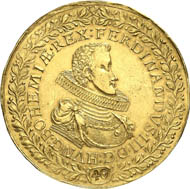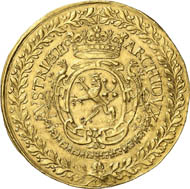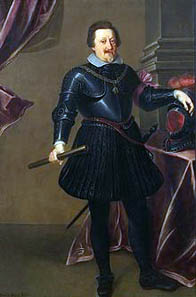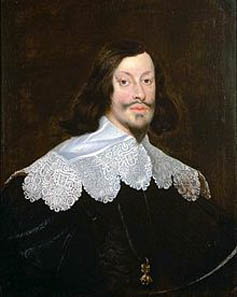FERDINANDVS III D G HVNG BOHEMIAE REX – Ferdinand III, through the grace of God, King of Hungary and Bohemia. This is what we read on this gorgeous gold piece, minted to mark the occasion of the coronation of Ferdinand III as ruler of Hungary and Bohemia. The piece, made in Prague, carries an exorbitant weight of 40 ducats. Why though, did Emperor Ferdinand II decide only in 1629 that this event should be celebrated through an extensive issue?
This splendid golden medallion from the Vogel Collection is coming up as nr 8051 for auction on October 30, 2012 in Künker auction 221 with an estimate of 150,000 euro.
His son’s coronation as King of Bohemia had actually already taken place on November 27, 1627. There were fireworks and various spectacles, public banquets and dances were held, red and white wine flowed freely and, serendipitously, the 19-year-old Ferdinand had won the jousting that held that same week marking the coronation of his stepmother. His coronation as King of Hungary had taken place even earlier, on December 8, 1625.
Georg Pachmann, Portrait of Emperor Ferdinand II (1578-1637), c.1635. Vienna, Kunsthistorisches Museum GG_3115. Source: Wikipedia.
And so the question remains: Why, in 1629 of all years, did Emperor Ferdinand II decide to bring out a splendid issue to the young King Ferdinand III? And it’s a unique splendid issue too: We know these medallions featuring the youthful portrait of the emperor’s son as gold coins of 100, 50 and 40 ducats and as silver coins of 12, 5 and 2 thalers. The range is carefully designed: the young man is wearing the high millstone ruffle, which found its way from Spanish court attire to Vienna. On the reverse he wears the Order of the Golden Fleece around his neck, reminiscent of the bust of the armoured and commander cloak-draped Roman emperor. The order encompasses a crowned shield with the Bohemian lion on it. Here, the inscription ARCHIDVX AVSTRIAE ET C – Archduke of Austria et cetera. The front and the reverse both encompass a laurel wreath.
This medallion presents us with an heir to the throne who is decorated with all the attributes a die-cutter would have had available to him at the time. It was a significant undertaking. But a quick look at the events that transpired in the year 1629 makes the fuss and expense much more understandable.
Albrecht von Wallenstein. Part of a portrait by Anthony Van Dyck, 1629 from a younger reprint. Source: Wikipedia.
It was the middle of the Thirty Years’ War. The Emperor had reached the point where he appeared to have emerged victor in the massive war. His commander, Wallenstein, had won the battle against the Danish King, Christian IV, in the Battle of Lutter, therefore eliminating him as defender of the Protestants. Gustavus Adolphus of Sweden had not yet landed in the territory of the Reich. The faction of the imperial princes was split. Everyone wanted a reduction in power for Wallenstein, who the Emperor had just made Duke of Mecklenburg. According to modern estimates, 125,000 men are said to have been under his command. But while the Catholics simply questioned Wallenstein’s appointment as Duke, the Protestants were also demanding the return of the County Palatine, which had been conferred upon the Duke of Bavaria. The emperor was so mighty that he could single-handedly proclaim the so-called Edict of Restitution and implement it, along with Wallenstein’s army. The edict denied the Calvinists the right to exist and also prohibited – retroactively! – all Protestants from acquiring church land.
Although Ferdinand could simply have sat back at this point, his imperial princes were in possession of a means of leverage that he simply couldn’t ignore – it was still the Electoral Princes who decided whom should become the next king of the Holy Roman Empire! By this point in time, Ferdinand was already 51 years old and had to start thinking about a successor. It’s in this context that the splendid coins must be seen, which the emperor doubtless sent around the whole country with his envoys. His legate wanted to negotiate with the imperial princes over the successor, and the weights of the coins that were likely brought along as gifts were carefully adapted according to the rank and level of influence held by the recipient.
Ferdinand III, Portrait by Frans Luycx (c.1638), Oil on canvas, Kunsthistorisches Museum Wien, Inv. No GG8024 (Schloss Ambras). Source: Wikipedia.
Today it’s assumed that Ferdinand had wanted to negotiate the dismissal of Wallenstein on the Ratisbon elector day for the election of his son as German king. Instead, he had to ask the electoral princes for military assistance, since Spanish relatives in the Netherlands felt they were being increasingly threatened. In exchange for their assistance, the electoral princes demanded not only Wallenstein’s deposition, but also the retraction of the Edict of Restitution. Ferdinand II had to relent. He sacrificed Wallenstein and the election of his son.
His son’s election as Holy Roman Emperor only came about shortly before Ferdinand II’s death. Ferdinand III was elected on December 22, 1636, and on February 15, 1637, his father died. Ferdinand III took over the war from his father, but the defeats at the hands of the Swedes, the assassination of Wallenstein and the devastation sustained in the German Empire meant that imperial power had diminished considerably. Never again would a Habsburg emperor have the opportunity to claim exclusive power over the fate and fortunes of the empire.
You will find Künker’s Rarities auctions here.
Additionally we offer you a detailed auction preview.








